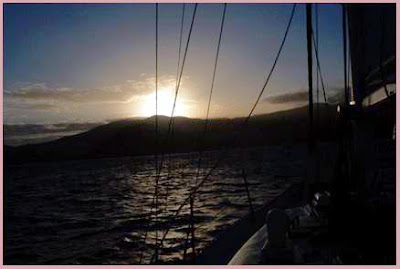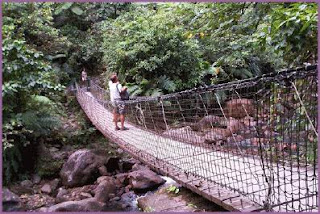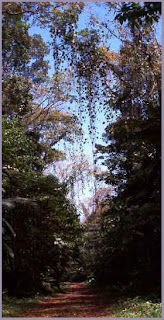Dawn over Deshaies in Guadeloupe

We reached Deshaies early in the morning – too early to go into the anchorage, so we lingered outside for a couple of hours until it was light enough to see everything. Here we found a nice little French influenced town. There were narrow streets with no pavements to speak of. Shops fronted onto the main street, with little bars and cafes everywhere. This was another opportunity for us to exercise our very limited French, and we were using Euro dollars (put the
The small attractive bay and village
All the shops and the houses in town have tiled floors. Even the front porches are tiled, and if there are steps – those too. Sometimes the tiles are nicely laid ceramic, but others look as though they are ordinary kitchen or bathroom tiles, sometimes broken up for a mosaic effect and set in concrete. Everything is always extremely clean.
Frequently a house door opens directly onto the pavement, with a couple of feet of tiled pavement area just outside. Everyone seems to have shrubs and plants growing in tubs and pots on their doorsteps, so it can be difficult to know if one is walking in a private area or a public footpath. Windows and doors are louvered and open most of the time, sometimes protected by a lightweight curtain.
One of the local small industries is the production of charcoal which used to be the main source of fuel, but since 1957 has become a less popular.
I read that the local vegetation is probably just the same as it was when Christopher Columbus first arrived in 1943, as this little fishing village is quite isolated from the rest of the island. The small protected harbour was a favorite shelter for pirates and buccaneers, so there may still be buried treasure nearby! There was an attempt to produce sugar locally, but because of continual plundering from the sea, the locals found they could get a better income by selling flour, potatoes and food, poultry and cattle to the various foreign ships passing through.
Derek and Mike on swing bridge in National Park
We met Derek on Dream Weaver here and one hot day we walked to the botanical gardens – only a mile and a quarter away according to the guide book. What we didn’t realize – the whole walk was uphill! And, having arrived, we discovered there was an entrance fee, so we didn’t even go in!
I did wander over to the area where on can buy plants – lots of impatiens, English ivy, fern and ficus trees! The most exotic plant was a tulip plant – but it is winter so maybe that makes a difference!
The alternator on Cheshire Cat has decided not to function – blowing fuses and giving us almost no voltage power. This after Mike thought he’d fixed the power problem in
Together with Derek we hired a car and took it to a
There is a superb National Park in the rain forest and we wanted to visit there and see the 350 foot Carbet Waterfalls on the mountain. There are three spectacular falls, and we toured around to find them. Following a sign for fall number three, the lowest falls, we drove up a steep hill, parked and continued on foot. We walked up a roughly cobbled road, which gradually became more of a track and eventually a muddy trek though a wonderful rainforest forest with
mahogany trees, fantastic ferns, bamboo stands and exotic plants.
Trail through the rain forest
After some considerable time and a couple of wrong turns on the poorly marked track, we eventually found the lowest falls. They was a mere 20 meters high, but clean and fresh, tumbling down the mountainside and through the large boulders on the river bed We sent some time clambering over the rocks at the base, paddling and getting cool before attempting the hike back.
Next stop – waterfall number 2. Here we parked in the park grounds and set off with the rest of the tourists along a beautifully paved walkway, across a stout mahogany wood bridge and up a trail which ended at the falls. The park is beautifully kept and obviously host to many visitors This waterfall was a lot higher, and again there was a fairly long but much less arduous trek tothe base. At 110 meters high it was quite spectacular, but our great joy was finding hot sulphur pools to soak our feet in right at the base of the falls.
The spectacular Carbet Falls
We were not able to make it to the summit and the greatest waterfall of all as there had been a landslide recently and the paths were closed to tourists. This was our first real experience of the rain forest, and I'm sure it will be yet another special memory. The silence in the forest, unfamiliar birdsong, seeing for the first time the vast leaves on many species of plants, the vines and the air-plants, exotic flowers, bamboo and mahogany trees provided an unforgettable memory.

